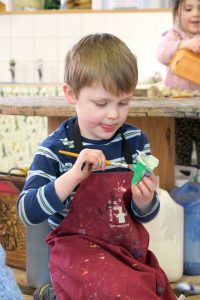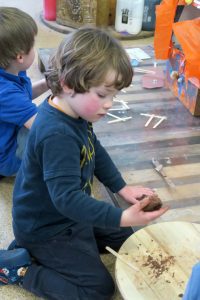The Role of an Atelierista
 The Role of an Atelierista
The Role of an Atelierista
The atelier and atelierista are integral parts of the Reggio Emilia approach. The atelierista, a teacher with a background in the arts, works together with children in the atelier (studio). Together they will often embark on long-term projects and experiment with a variety of creative mediums. The atelier is a learning space and shared environment where children can express themselves through ‘the hundred languages’. This may be through singing, drawing, dancing, clay or natural materials. ‘The hundred languages’ represents the infinite potential where children can express their learnings, feelings and ways in which they comprehend the world.
As an atelierista, I have witnessed how effective the Reggio-inspired approach is in contrast to traditional education. Children have an innate sense of curiosity and awe and when presented with a range of resources and materials, they expand their inquisitive minds. Interestingly, artists are often trying to channel this child-like wonder, exploring with a sense of openness without the restriction of doubts and fears. Therefore, I believe in utilising this inner curiosity and creating a space where life-long learners and artists can emerge.
 Rather than conforming to the role of a teacher in a traditional sense, as an atelierista I learn alongside the children whilst encouraging problem solving, expression and communication. Together we are on an exciting adventure and learning process that unfolds before our eyes. In their own time, the children begin to master techniques and familiarise themselves with different mediums. This also provides me the opportunity to understand the different ways children learn, to observe each child as a unique individual.
Rather than conforming to the role of a teacher in a traditional sense, as an atelierista I learn alongside the children whilst encouraging problem solving, expression and communication. Together we are on an exciting adventure and learning process that unfolds before our eyes. In their own time, the children begin to master techniques and familiarise themselves with different mediums. This also provides me the opportunity to understand the different ways children learn, to observe each child as a unique individual.
Observing, listening, documenting and reflecting are essential to the role of an atelierista. Significantly, being alert and aware is crucial to witness the children’s discoveries, to hear meaningful conversations or to ask thought provoking questions. Only after this process can quotes, observations and notes be written. This documentation allows for deep reflection for both the atelierista and the children, in which interests, learning and progress can be shared. For me, it also reveals subtle patterns about the children’s behaviour and can indicate which direction we might take next. Documentation also enables me to truly listen to the voice of the child and respect their learning journey.
During my time as an atelierista, I am constantly surprised and delighted with what children discover. Each day is a new opportunity for exploration and insights, often stepping back and allowing for that magic to happen takes learning to a new level. This process, rather than the final product, is ultimately the most important part of a child’s journey. I think even as adults, we would benefit from engaging in the world with curiosity and to trust the process.
Julie Lai
